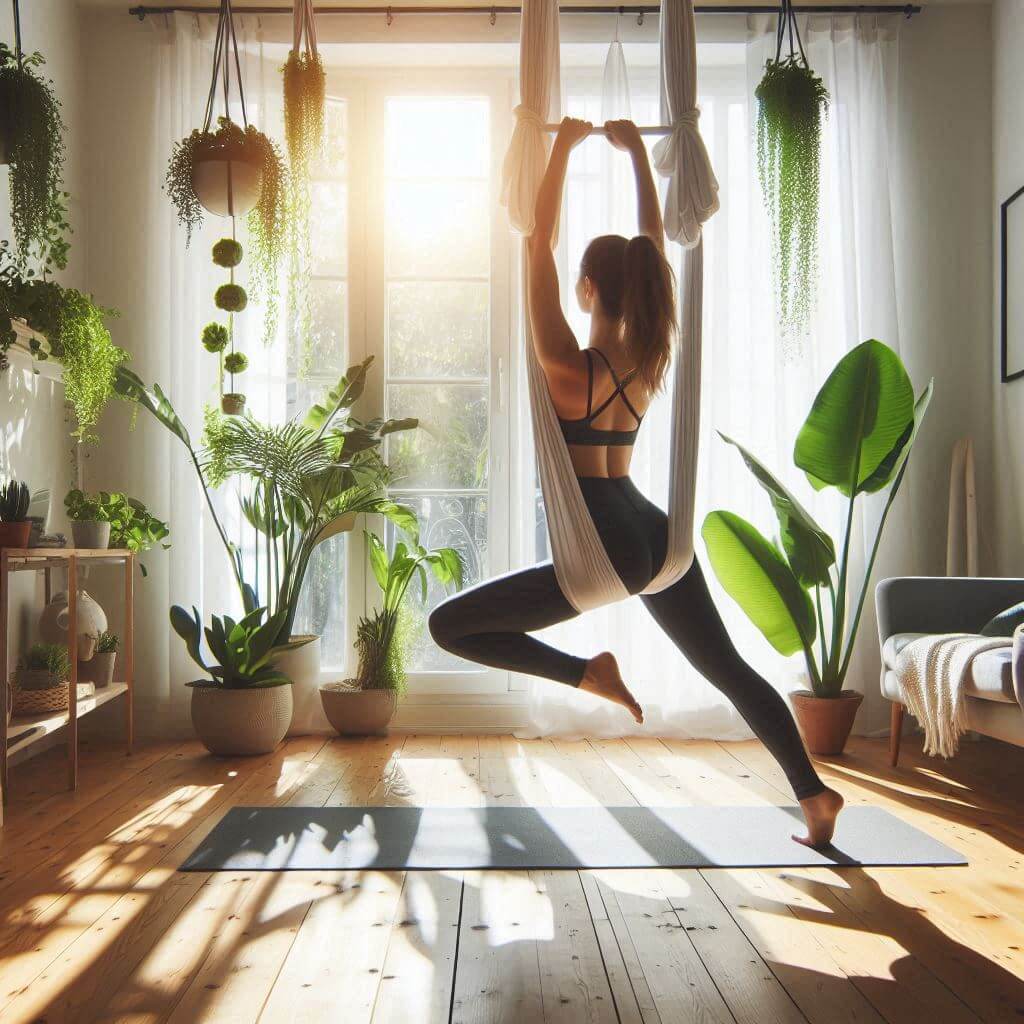Aerial yoga, which involves performing yoga poses suspended in the air using a fabric hammock, has gained immense popularity in recent years. This new twist on traditional yoga offers a unique combination of physical benefits and satisfaction. As practitioners hang and swing in the hammocks, they can experience a new perspective on their body and mind.
Physical Benefits of Aerial Yoga
Aero yoga can provide a number of specific physical benefits. Hanging in the air allows you to take poses that are difficult or impossible to achieve on the ground, which greatly contributes to the increase in flexibility and mobility of the joints. Fabric hammocks provide support, allowing you to perform stretches and bends with proper alignment and reducing the risk of injury. This support also allows for a deeper stretch, targeting muscle groups that may be difficult to reach in traditional yoga poses.
Aerial yoga also helps build overall body strength, especially core muscles. The act of stabilizing yourself in a suspended state requires constant core engagement. This constant work strengthens the muscles of the press, lower back, and oblique muscles. Additionally, many aerial yoga poses focus on inversions, where the body is turned upside down. It requires and develops considerable upper body strength, especially in the arms and shoulders, as practitioners must hold on to the hammock and control their movements.
 Doing aerial yoga can also improve spinal health. The gentle grip created by hanging upside down can help decompress the spine. This can reduce pressure on the vertebrae and discs, potentially reducing back pain. Many doctors and physical therapists recommend inversion therapy for patients with spinal problems, and aerial yoga provides a way to achieve similar benefits in a controlled environment.
Doing aerial yoga can also improve spinal health. The gentle grip created by hanging upside down can help decompress the spine. This can reduce pressure on the vertebrae and discs, potentially reducing back pain. Many doctors and physical therapists recommend inversion therapy for patients with spinal problems, and aerial yoga provides a way to achieve similar benefits in a controlled environment.
Another benefit of aerial yoga is improving balance and coordination. Practicing poses in a hammock requires participants to constantly adjust their position and maintain balance. This can strengthen the stabilizer muscles, which play a critical role in maintaining balance and posture. Improved coordination is useful not only in yoga but also in everyday movements and other physical activities.
In addition, aerial yoga can strengthen the cardiovascular system. Many aerial yoga sequences involve continuous movement, smoothly transitioning from one pose to another. This dynamic flow increases heart rate and can improve cardiovascular health over time. Improved cardiovascular health means better endurance and energy levels.
Aero yoga can also help with weight control. The physical demands of the practice can burn a significant number of calories. Although it may not be as high-intensity as some other types of exercise, a combination of strength training, stretching, and cardiovascular work can help you lose weight and tone your muscles. As a full-body workout, it engages multiple muscle groups at the same time, increasing total calorie expenditure.
Aerial yoga can improve proprioception, which is the body’s ability to sense its position in space. The unique challenge of constantly adapting to the movement of the hammock heightens this sensation, resulting in more precise and controlled physical actions. Improved proprioception can contribute to athletic performance in other areas and contribute to overall body coordination and safety.
Mental And Emotional Benefits
In addition to the physical benefits, aerial yoga offers a unique set of mental and emotional benefits. Outdoor yoga can be extremely therapeutic and stress-relieving. The feeling of weightlessness and the gentle rocking of the hammock can induce a feeling of peace and relaxation. It helps reduce stress and promote mental clarity. Aerial Yoga’s unique environment encourages mindfulness as practitioners focus on breathing, body movement, and the sensation of being suspended.
The act of trusting the hammock and letting it go can be a powerful exercise in overcoming fears and building confidence. Many people may find it scary at first when they are suspended in the air, but gradually gaining confidence in the hammock can turn into a feeling of empowerment in other areas of life. Achieving mastery of difficult poses in the air can boost self-esteem and create a sense of accomplishment.
In addition to individual benefits, aerial yoga can promote a sense of community and connection. Group classes provide an opportunity to share experiences with others, build relationships, and support each other’s progress. The shared experience of trying something new and challenging can create bonds and a sense of camaraderie between participants.
Differences Between Aerial And Traditional Yoga
Aerial yoga represents a new approach to the ancient practice of yoga, and while it shares many elements with traditional yoga, it has some key differences. One of the most obvious differences is the use of a hammock. This fabric sling provides support, allowing practitioners to achieve deeper stretches and perform poses that may be more challenging on the floor. The support of a hammock reduces pressure on joints and can make difficult poses more accessible to beginners or those with physical limitations.
The nature of the hammock also allows for a variety of smooth and dynamic movements. Swinging, spinning, and hanging upside down brings an element of playfulness and fun to the practice. These movements can create a sense of freedom and upliftment, transforming the yoga experience into something carefree and enjoyable. This contrasts with the often grounded and still nature of traditional yoga poses.
Despite these differences, it is important to note that aerial yoga still follows the basic principles of traditional yoga. The focus on breath awareness, alignment, and mindful movement is maintained. Both forms aim to develop the mind-body connection and promote overall well-being. The main difference is how these principles apply in the context of being in the air.
Getting Started with Aerial Yoga
For those intrigued by the idea of defying gravity and improving their health and well-being, Aero Yoga is relatively easy to get started. The first step is to find a reputable aerial yoga studio or an experienced instructor. Look for classes designed for beginners as they will provide an easy and gradual introduction to techniques and equipment. Instructors with experience in Aero Yoga will ensure that participants feel safe and supported as they learn to use the hammocks.
Comfortable, close-fitting clothing is recommended to prevent fabric burns caused by loose clothing rubbing against the hammock. You should also avoid jewelry and accessories that can catch on the fabric. Coming to class with an open mind and willingness to try something new will enhance the experience.
During the initial sessions, participants can expect to learn the basics of using a hammock, including how to get in and out of it safely. The instructor will guide them through a series of poses and movements, gradually building confidence and familiarity with the equipment. As with any physical activity, it’s important to listen to your body and not exceed your personal limits. Practicing patience and persistence will eventually lead to noticeable progress.
Once the basics are mastered, practitioners can explore more complex poses and transitions. The versatility of aerial yoga allows for continuous growth and challenge. Whether the goal is to improve flexibility, build strength, or just have fun, aerial yoga offers a rewarding and dynamic way to achieve those goals.
